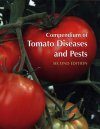About this book
Botanically speaking, tomato is a fruit. But by common understanding it is often considered a vegetable as well. Regardless of which term you use, tomato is the most "Googled" fruit and one of the most commonly grown.
Unfortunately, tomato plants are also a common target for many diseases and pests, affecting production for anyone growing the crop, including commercial producers trying to maximize yield and the small scale gardener who wants flawless and flavorful garden fresh tomatoes for salads, cooking, and canning.
Enter Compendium of Tomato Diseases and Pests, Second Edition. The nearly 250 images and associated information in this highly useful and significantly upgraded book allows anyone-from the gardener to professional-to identify, understand, diagnose, and treat more than 60 diseases of tomato occurring throughout the world. This impressive new handbook, written by expert plant pathologists working with this crop, includes nearly 20 new diseases and disorders, including those caused by fungi and oomycetes, bacteria, phytoplasmas, viruses and viroids.
The previous edition of Compendium of Tomato Diseases was a top-10 best-seller in the Compendium Series and the new edition is even more useful with important coverage of arthropod pests: namely, mites, insects, and "worm" pests. The coverage of pests has been expanded significantly in this edition and includes the addition of 23 color photos from expert entomologists that illustrate these pests and the damage they cause.
This scientifically peer-reviewed information on numerous diseases and pests provides just the right amount of supporting information for users to make accurate decisions for disease and pest control. Throughout the Compendium of Tomato Diseases and Pests, Second Edition, disorders are both illustrated and discussed in sections that follow an easy-to-use and consistent structure: a statement of its importance and distribution, identification of its common signs and symptoms, a description of its causal organism or agent, an explanation of its cycle and epidemiology, and recommendations for management.
This easy format allows the user to quickly identify signs and symptoms of important tomato diseases and pests occurring throughout the world – in the greenhouse, in the field or garden, and in transit to the market.
Individuals with a range of skill and expertise can use Compendium of Tomato Diseases effectively, including field and greenhouse growers, home and master gardeners, consultants, horticulturalists, extension agents, entomologists, diagnosticians, plant pathologists, educators, and students. Those who work in postharvest channels, including tomato and canning storage facilities will also benefit from Compendium of Tomato Diseases.
Given its compact size, it can be taken directly to the affected tomato crop, where the pictures and symptom descriptions can be compared for diagnosis. Each individual description was written and each high-quality image was chosen by recognized scientists in the tomato industry. The expertise, thoroughness, portability, and simple format of this important book make it both a bargain and an essential tool for literally any tomato professional or enthusiast.
Contents
Introduction
Tomato Diseases, Pests, and Disorders
Botany and Culture
Seed Production and Quality Assurance
Containerized Production of Tomato Transplants
PART I. Infectious Diseases
Diseases Caused by Fungi and Oomycetes
Diseases Caused by Bacteria
Diseases Caused by Phytoplasmas
Diseases Caused by Viruses
Diseases Caused by Viroids
Postharvest Diseases and Disorders
Diseases Caused by Nematodes
Part II. Arthropod Pests
Mites
Insects
“Worm” Pests
Part III. Noninfectious Diseases, Disorders, and Damage
Physiological Diseases
Nutritional Disorders
Herbicide Damage
Genetic Diseases
Part IV. Diseases of Undetermined Etiology
Glossary
Index
Customer Reviews





































![Nuevo Diccionario Ilustrado de Micologia [New Illustrated Dictionary of Mycology]](http://mediacdn.nhbs.com/jackets/jackets_resizer_medium/15/157811.jpg?height=150&width=113)







